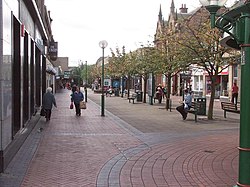Grangemouth
Grangemouth
|
|
|---|---|
 Grangemouth town centre |
|
| Grangemouth shown within the Falkirk council area | |
| Area | 4.12 sq mi (10.7 km2) |
| Population | 17,906 (2001 census) |
| • Density | 4,346/sq mi (1,678/km2) |
| OS grid reference | NS935815 |
| • Edinburgh | 21.0 mi (33.8 km) SE |
| • London | 345 mi (555 km) SSE |
| Council area | |
| Lieutenancy area | |
| Country | Scotland |
| Sovereign state | United Kingdom |
| Post town | GRANGEMOUTH |
| Postcode district | FK3 |
| Dialling code | 01324 |
| Police | Scottish |
| Fire | Scottish |
| Ambulance | Scottish |
| EU Parliament | Scotland |
| UK Parliament | |
| Scottish Parliament | |
| Website | falkirk.gov.uk/search/?q=grangemouth |
Grangemouth is a town in east Stirlingshire and is part of the Falkirk council area, Scotland. The town lies in the Forth Valley, on the banks of the Firth of Forth, 3 miles (4.8 km) east of Falkirk, 5 miles (8.0 km) west of Bo'ness and 13 miles (20.9 km) south-east of Stirling. Grangemouth had a resident population of 17,906 according to the 2001 Census. Preliminary figures from the 2011 census reported the number as 17,373.
Grangemouth's original growth as a town relied mainly on its geographical location. Originally a bustling port, trade flowed through the town with the construction of the Forth and Clyde Canal in the 18th century. Nowadays, the economy of Grangemouth is focused primarily on the large petrochemical industry of the area which includes the oil refinery, owned by Ineos, one of the largest of its kind in Europe. The town is twinned with La Porte, Indiana.
Residents of the town are known as Portonians.
Grangemouth was founded by Sir Lawrence Dundas in 1768 as a result of the construction of the Forth and Clyde Canal. Originally referred to as Sealock by workers brought in to labour on the canal digging and lock constructions, the name referred to the Forth and Clyde Canal connection to the sea and where it flowed into the River Forth. This township name was never approved by the founders.
The settlement was also named Grangeburnmouth for a period and then finally to Grangemouth. A map held at the National Library of Scotland dated 1817 by John Grassom, records the town as Grangemouth. This more properly refers to its location at the mouth of the Grange Burn which flows into the River Forth at this time even though originally it flowed directly into the River Carron in the late 18th and early 19th centuries.
...
Wikipedia

